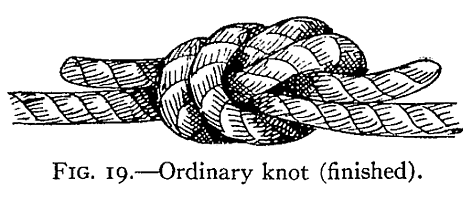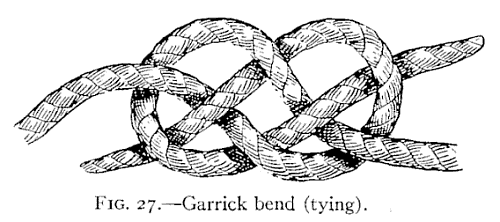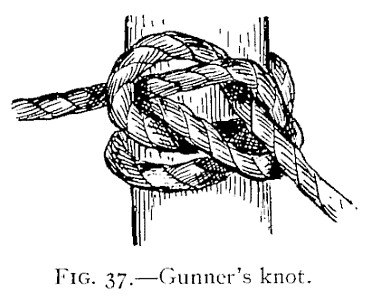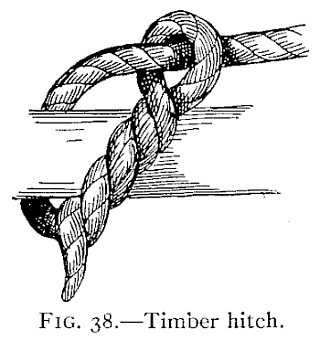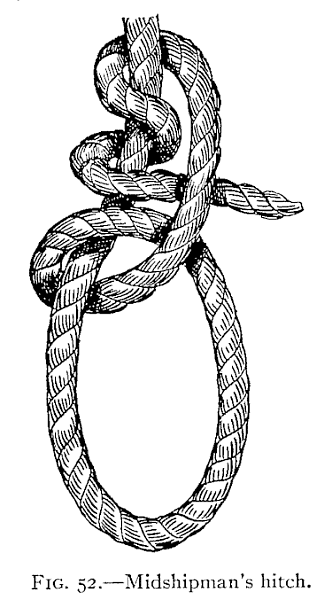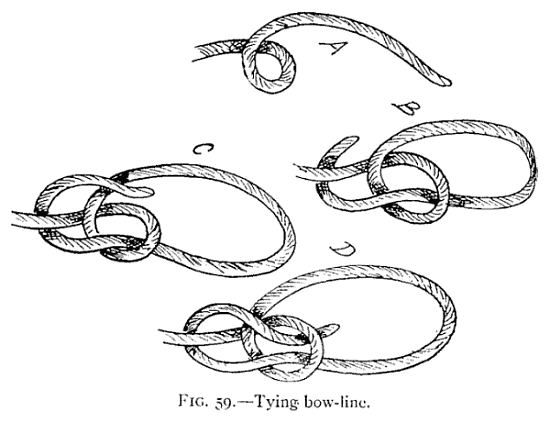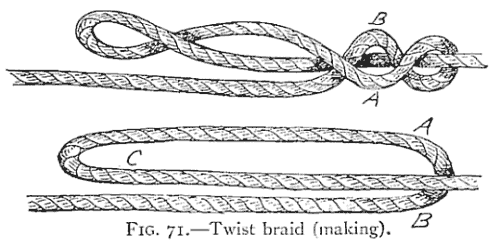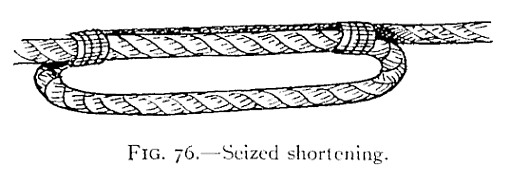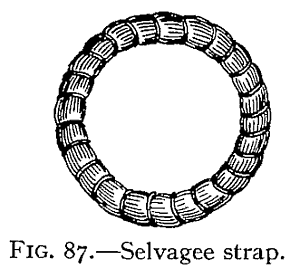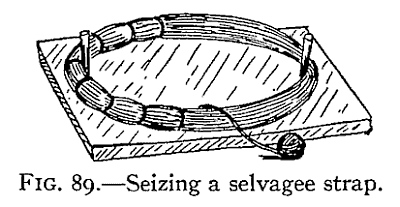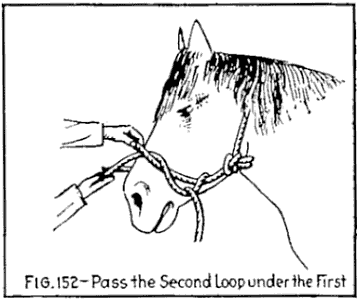The Project Gutenberg eBook, Knots, Splices and Rope Work, by A. Hyatt
Verrill
|
Transcriber's Notes:
|
Corrected spellings
'casualities' to 'casualties'
'Midshipmen's hitch' to 'Midshipman's hitch'
Illustration for Timber Hitch is Fig. 38, not Fig. 32
There is no Fig. 134.
|
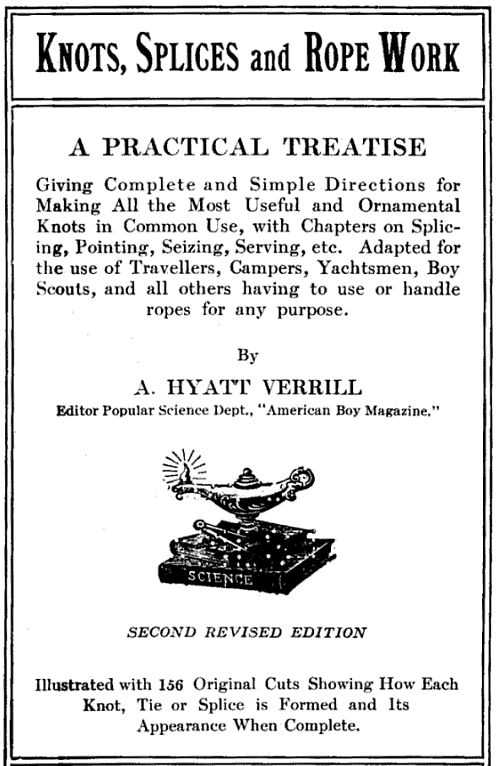
KNOTS, SPLICES and ROPE WORK
A PRACTICAL TREATISE
Giving Complete and Simple Directions for Making All the Most Useful
and Ornamental Knots in Common Use, with Chapters on Splicing,
Pointing, Seizing, Serving, etc. Adapted for the Use of Travellers,
Campers, Yachtsmen, Boy Scouts, and All Others Having to Use or Handle
Ropes for Any Purpose.
By
A. HYATT VERRILL
Editor Popular Science Dept., "American Boy Magazine."
SECOND REVISED EDITION
Illustrated with 156 Original Cuts Showing How
Each Knot, Tie or
Splice is Formed and Its
Appearance When Complete.
CONTENTS
CORDAGE
Kinds of Rope. Construction of Rope. Strength of Ropes. Weight of
Ropes. Material Used in Making Ropes.
SIMPLE KNOTS AND BENDS
Parts of Rope. Whipping and Seizing Rope. Loops. Cuckolds' Necks.
Clinches. Overhand and Figure-eight Knots. Square and Reef Knots.
Granny Knots. Open-hand and Fishermen's Knots. Ordinary Knots and
Weavers' Knots. Garrick Bends and Hawser Hitches. Half-hitches.
TIES AND HITCHES
Larks' Heads. Slippery and Half-hitches. Clove Hitches. Gunners' Knots
and Timber Hitches. Twists, Catspaws, and Blackwall Hitches. Chain
Hitch. Rolling and Magnus Hitches. Studding-sail and Gaff-topsail
Halyard Bends. Roband and Fisherman's Hitches.
NOOSES, LOOPS, AND MOORING KNOTS
Waterman's Knot. Larks' Heads with Nooses. Cleat and Wharf Ties.
Bow-line Knots. Loops and Loop Knots.
SHORTENINGS, GROMMETS, AND SELVAGEES
Two-, Three-, and Fivefold Shortenings. Single Plaits and Monkey
Chain. Twist Braids and Braiding Leather. Open Chains. Seized and Bow
Shortenings. Sheepshanks and Dogshanks. Grommets. Selvagee Straps and
Selvagee Boards. Flemish and Artificial Eyes. Throat Seizings. Lashed Splices.
LASHINGS, SEIZINGS, SPLICES, ETC.
Wedding Knots and Rose Lashings. Deadeye and Loop Lashings.
Belaying-pin Splice. Necklace Ties. Close Bands and End Pointing.
Ending Ropes. Short Splices. Long Splices. Eye and Cut Splices.
FANCY KNOTS AND ROPE WORK
Single Crown Knots. Tucked Crowns. Single Wall Knots. Common and
French Shroud Knots. Double Crown and Double Wall Knots. Crowning Wall
Knots. Double Wall and Crown. Manrope Knots. Topsail-halyard Toggles.
Matthew Walker and Stopper Knots. Turks' Heads and Turks' Caps.
Worming, Parcelling, and Serving. Serving Mallet. Half-hitch Work.
Four-strand and Crown Braids. Rope Buckles and Swivels. Slinging Casks
and Barrels. Rope Belting.
INTRODUCTION
The history of ropes and knots is so dim and ancient that really
little is known of their origin. That earliest man used cordage of
some kind and by his ingenuity succeeded in tying the material
together, is indisputable, for the most ancient carvings and
decorations of prehistoric man show knots in several forms. Doubtless
the trailing vines and plants first suggested ropes to human beings;
and it is quite probable that these same vines, in their various
twistings and twinings, gave man his first idea of knots.
Since the earliest times knots have been everywhere interwoven with
human affairs; jugglers have used them in their tricks; they have
become almost a part of many occupations and trades, while in song and
story they have become the symbol of steadfastness and strength.
Few realize the importance that knots and cordage have played in the
world's history, but if it had not been for these simple and every-day
things, which as a rule are given far too little consideration, the
human race could never have developed beyond savages. Indeed, I am not
sure but it would be safe to state that the real difference between
civilized and savage man consists largely in the knowledge of knots
and rope work. No cloth could be woven, no net or seine knitted, no
bow strung and no craft sailed on lake or sea without numerous knots
and proper lines or ropes; and Columbus himself would have been far
more handicapped without knots than without a compass.
History abounds with mention of knots, and in the eighth book of
"Odyssey" Ulysses is represented as securing various articles of
raiment by a rope fastened in a "knot closed with Circean art"; and as
further proof of the prominence the ancients gave to knots the famous
Gordian Knot may be mentioned. Probably no one will ever learn just
how this fabulous knot was tied, and like many modern knots it was
doubtless far easier for Alexander to cut it than to untie it.
The old sorcerers used knots in various ways, and the witches of
Lapland sold sailors so-called "Wind Knots," which were untied by the
sailors when they desired a particular wind. Even modern conjurors and
wizards use knots extensively in their exhibitions and upon the
accuracy and manner in which their knots are tied depends the success
of their tricks.
In heraldry many knots have been used as symbols and badges and many
old Coats of Arms bear intricate and handsome knots, or entwined
ropes, emblazoned upon them.
As to the utility of knots and rope work there can be no question. A
little knowledge of knots has saved many a life in storm and wreck,
and if every one knew how to quickly and securely tie a knot there
would be far fewer casualties in hotel and similar fires. In a
thousand ways and times a knowledge of rope and knots is useful and
many times necessary. Many an accident has occurred through a knot or
splice being improperly formed, and even in tying an ordinary bundle
or "roping" a trunk or box few people tie a knot that is secure and
yet readily undone and quickly made. In a life of travel and adventure
in out-of-the-way places, in yachting or boating, in hunting or
fishing, and even in motoring, to command a number of good knots and
splices is to make life safer, easier, and more enjoyable, aside from
the real pleasure one may find in learning the interesting art of
knot-tying.
Through countless ages the various forms of knots and fastenings for
rope, cable, or cord have been developed; the best kinds being
steadily improved and handed down from generation to generation, while
the poor or inferior fastenings have been discarded by those whose
callings required the use of cordage.
Gradually, too, each profession or trade has adopted the knots best
suited to its requirements, and thus we find the Sailor's Knot; the
Weaver's Knot; Fishermen's knots; Builders' knots; Butchers' knots;
and many others which have taken their names from the use to which
they are especially adapted.
In addition to these useful knots, there are many kinds of ornamental
or fancy knots used in ornamenting the ends of ropes, decorating
shrouds of vessels, railings, and similar objects; while certain
braids or plaits, formed by a series of knots, are widely used aboard
ship and on land.
In many cases ropes or cable must be joined in such a way that they
present a smooth and even surface and for such purposes splices are
used, while knots used merely as temporary fastenings and which must
be readily and quickly tied and untied are commonly known as "bends"
or "hitches." Oddly enough, it is far easier to tie a poor knot than a
good one, and in ninety-nine cases out of a hundred the tyro, when
attempting to join two ropes together, will tie either a "slippery" or
a "jamming" knot and will seldom succeed in making a recognized and
"ship-shape" knot of any sort.
The number of knots, ties, bends, hitches, splices, and shortenings in
use is almost unlimited and they are most confusing and bewildering to
the uninitiated. The most useful and ornamental, as well as the most
reliable, are comparatively few in number, and in reality each knot
learned leads readily to another; in the following pages I have
endeavored to describe them in such a manner that their construction
may be readily understood and mastered.
THE AUTHOR.
JANUARY, 1917.
CHAPTER I
CORDAGE
Before taking up the matter of knots and splices in detail it may be
well to give attention to cordage in general. Cordage, in its broadest
sense, includes all forms and kinds of rope, string, twine, cable,
etc., formed of braided or twisted strands.

In making a rope or line
the fibres (A, Fig. 1) of hemp, jute, cotton, or other material are
loosely twisted together to form what is technically known as a "yarn"
(B, Fig. 1). When two or more yarns are twisted together they form a
"strand" (C, Fig. 1). Three or more strands form a rope (D, Fig.
1), and three ropes form a cable (E, Fig. 1). To form a strand the
yarns are twisted together in the opposite direction from that in
which the original fibres were twisted; to form a rope the strands are
twisted in the opposite direction from the yarns of the strands, and
to form a cable each rope is twisted opposite from the twist of the
strands. In this way the natural tendency for each yarn, strand, or
rope to untwist serves to bind or hold the whole firmly together (Fig. 1).

Rope is usually three-stranded and the strands turn from left to right
or "with the sun," while cable is left-handed or twisted "against the
sun" (E, Fig. 1). Certain ropes, such as "bolt-rope" and most
cables, are laid around a "core" (F, Fig. 2) or central strand and
in many cases are four-stranded (Fig. 2).
The strength of a rope depends largely upon the strength and length of
the fibres from which it is made, but the amount each yarn and strand
is twisted, as well as the method used in bleaching or preparing the
fibres, has much to do with the strength of the finished line.
Roughly, the strength of ropes may be calculated by multiplying the
circumference of the rope in inches by itself and the fifth part of
the product will be the number of tons the rope will sustain. For
example, if the rope is 5 inches in circumference, 5 X 5 = 25,
one-fifth of which is 5, the number of tons that can safely be carried
on a 5-inch rope. To ascertain the weight of ordinary "right hand"
rope, multiply the circumference in inches by itself and multiply, the
result by the length of rope in fathoms and divide the product by
3.75. For example, to find the weight of a 5-inch rope, 50 fathoms in
length: 5 X 5 = 25; 25 x 50 = 1,250; 1,250 ÷ 3.75 = 333-1/3 lbs. These
figures apply to Manila or hemp rope, which is the kind commonly used,
but jute, sisal-flax, grass, and silk are also used considerably.
Cotton rope is seldom used save for small hand-lines, clothes-lines,
twine, etc., while wire rope is largely used nowadays for rigging
vessels, derricks, winches, etc., but as splicing wire rope is
different from the method employed in fibre rope, and as knots have no
place in wire rigging, we will not consider it.
CHAPTER II
SIMPLE KNOTS AND BENDS
For convenience in handling rope and learning the various knots, ties,
and bends, we use the terms "standing part," "bight," and "end" (Fig.
3). The Standing Part is the principal portion or longest part of
the rope; the Bight is the part curved or bent while working or
handling; while the End is that part used in forming the knot or
hitch. Before commencing work the loose ends or strands of a rope
should be "whipped" or "seized" to prevent the rope from unravelling;
and although an expert can readily tie almost any knot, make a splice,
or in fact do pretty nearly anything with a loose-ended rope, yet it
is a wise plan to invariably whip the end of every rope, cable, or
hawser to be handled, while a marline-spike, fid, or pointed stick
will also prove of great help in working rope.

To whip or seize a rope-end, take a piece of twine or string and lay
it on the rope an inch or two from the end, pass the twine several
times around the rope, keeping the ends of the twine under the first
few turns to hold it in place; then make a large loop with the free
end of twine; bring it back to the rope and continue winding for three
or four turns around both rope and end of twine; and then finish by
drawing the loop tight by pulling on the free end (Fig. 4).
All knots are begun by "loops" or rings commonly known to mariners as
"Cuckolds' Necks" (Fig. 5).
These may be either overhand or underhand,
and when a seizing or fastening of twine is placed around the two
parts where they cross a useful rope ring known as a "clinch" is
formed (Fig. 6).
If the loose end of the rope is passed over the
standing part and through the "cuckold's-neck," the simplest of all
knots, known as the "Overhand Knot," is made (Fig. 7).
This drawn tight appears as in Fig. 8, and while so simple this knot is
important, as it is frequently used in fastening the ends of yarns and
strands in splicing, whipping, and seizing.
The "Figure-Eight Knot" is almost as simple as
the overhand and is plainly shown in Figs. 9 and 10.
Only a step beyond the figure-eight and the overhand knots are the
"Square" and "Reefing" knots (Figs. 11 and 12). The square knot is
probably the most useful and widely used of any common knot and is the
best all-around knot known. It is very strong, never slips or becomes
jammed, and is readily untied. To make a square knot, take the ends of
the rope and pass the left end over and under the right end, then the
right over and under the left.
If you once learn the simple formula of
"Left over," "Right over," you will never make a mistake and form the
despised "Granny," a most useless, bothersome, and deceptive makeshift
for any purpose (Fig. 13). The true "Reef Knot" is merely the square
knot with the bight of the left or right end used instead of the end
itself. This enables the knot to be "cast off" more readily than the
regular square knot (A, Fig. 12).
Neither square nor reef knots, however, are reliable when tying two ropes
of unequal size together, for under such conditions they will frequently slip
and appear as in Fig. 14, and sooner or later will pull apart.
To prevent this the ends may be tied or seized as shown in Fig. 15.
A better way to join two ropes of unequal diameter is to use the "Open-hand Knot."
This knot is shown in Fig. 16, and is very quickly and easily made; it never slips
or gives, but is rather large and clumsy, and if too great a strain
is put on the rope it is more likely to break at the knot than at any other spot.
The "Fisherman's Knot," shown in Fig. 17, is a good knot
and is formed by two simple overhand knots slipped over each rope, and
when drawn taut appears as in Fig. 18.
This is an important and valuable knot for anglers, as the two lines may be drawn apart
by taking hold of the ends, A, B, and a third line for a sinker, or
extra hook, may be inserted between them. In joining gut lines the
knot should be left slightly open and the space between wrapped with
silk. This is probably the strongest known method of fastening fine lines.
The "Ordinary Knot," for fastening heavy ropes, is shown in Fig. 19.
It is made by forming a simple knot and then interlacing the other
rope or "following around," as shown in Fig. 20. This knot is very
strong, will not slip, is easy to make, and does not strain the
fibres of the rope. Moreover, ropes joined with this knot will pay
out, or hang, in a straight line.
By whipping the ends to the standing parts it becomes a neat and handsome knot (Fig. 21).
The "Weaver's Knot" (Fig. 22) is more useful in joining small lines, or twine,
than for rope, and for thread it is without doubt the best knot known.
The ends are crossed as in Fig. 23. The end A is then looped back over
the end B, and the end B is slipped through loop C and
drawn tight.
Another useful and handsome knot is illustrated in Fig. 24. This is a
variation of the figure-eight knot, already described, and is used
where there is too much rope, or where a simple knot is desired to
prevent the rope running through an eye, ring, or tackle-block.
It is made by forming a regular figure eight and then "following round" with
the other rope as in Fig. 25. It is then drawn taut and the ends
seized to the standing part if desired.
Sometimes we have occasion to join two heavy or stiff ropes or
hawsers, and for this purpose the "Garrick Bend" (Fig. 26) is
preeminently the best of all knots. To make this knot, form a bight by
laying the end of a rope on top of and across the standing part.
Next take the end of the other rope and pass it through this bight, first
down, then up, over the cross and down through the bight again, so
that it comes out on the opposite side from the other end, thus
bringing one end on top and the other below, as illustrated in Fig.
27. If the lines are very stiff or heavy the knot may be secured by
seizing the ends to the standing parts.
A much simpler and a far poorer knot is sometimes used in fastening two
heavy ropes together. This is a simple hitch within a loop, as illustrated in Fig. 28,
but while it has the advantage of being quickly and easily tied it is so
inferior to the Garrick bend that I advise all to adopt the latter in its place.
When two heavy lines are to be fastened for any considerable time, a
good method is to use the "Half-hitch and Seizing," shown in Fig. 29.
This is a secure and easy method of fastening ropes together and it
allows the rope to be handled more easily, and to pass around a winch
or to be coiled much more readily, than when other knots are used.
CHAPTER III
TIES AND HITCHES
All the knots I have so far described are used mainly for fastening
the two ends of a rope, or of two ropes, together. Of quite a
different class are the knots used in making a rope fast to a
stationary or solid object, and are known as "hitches" or "ties."
One of the easiest of this class to make and one which is very useful
in fastening a boat or other object where it may be necessary to
release it quickly is the "Lark's Head" (Fig. 30). To make this tie,
pass a bight of your rope through the ring, or other object, to which
you are making fast and then pass a marline-spike, a billet of wood,
or any similar object through the sides of the bight and under or
behind the standing part, as shown in A, Fig. 30.
The end of the rope may then be laid over and under the standing part and back over
itself. This knot may be instantly released by merely pulling out the toggle.
Almost as quickly made and unfastened is the "Slippery Hitch"
(Fig. 32).
To make this, run the end of the rope through the ring or
eye to which it is being fastened, then back over the standing part
and pull a loop, or bight, back through the "cuckold's neck" thus
formed (Fig. 33). To untie, merely pull on the free end.
Two half-hitches, either around a post or timber or around the standing
part of the rope, make an ideal and quickly tied fastening (Figs. 34
and 35). To make these, pass the end around the post, ring, or other
object, then over and around the standing part between the post and
itself, then under and around the standing part and between its own
loop and the first one formed. After a little practice you can tie
this knot almost instantly and by merely throwing a couple of turns
around a post, two half-hitches may be formed instantly. This knot
will hold forever without loosening, and even on a smooth, round stick
or spar it will stand an enormous strain without slipping.
A more secure knot for this same purpose is the "Clove Hitch" (Fig. 36),
sometimes known as the "Builders' Hitch."
To make this, pass the end of rope around the spar or timber, then over itself;
over and around the spar, and pass the end under itself and between rope and spar,
as shown in the illustration.
The Clove hitch with ends knotted becomes
the "Gunners' Knot" (Fig. 37). These are among the most valuable and
important of knots and are useful in a thousand and one places. The
Clove hitch will hold fast on a smooth timber and is used extensively
by builders for fastening the stageing to the upright posts. It is
also useful in making a tow-line fast to a wet spar, or timber, and
even on a slimy and slippery spile it will seldom slip.
For this purpose the "Timber Hitch" (Fig. 38) is even better than
the Clove hitch. It is easily made by passing the end of a rope around the spar
or log, round the standing part of the rope and then twist it three or
more times around, under and over itself.
If you wish this still more secure, a single half-hitch may be taken with the line
a couple of feet further along the spar (Fig. 39).
It is remarkable what power to grip a twisted rope has, and the "Twist
Knots" shown in Figs. 40 and 41 illustrate two ways of making fast
which are really not knots at all but merely twists.
These may be finished by a simple knot, or a bow-knot, as shown in Fig. 42,
but they are likely to jam under great pressure and are mainly useful in
tying packages, or bundles, with small cord, where the line must be
held taut until the knot is completed.
This principle of fastening by
twisted rope is also utilized in the "Catspaw" (Fig. 43), a most
useful knot or "hitch" for hoisting with a hook.
To make this, pass the bight of your rope over the end and standing part, then,
with a bight in each hand, take three twists from you, then bring the two
bights side by side and throw over the hook (Fig. 44).
The "Blackwall Hitch" (Fig. 45) is still simpler and easier to make
and merely consists of a loop, or cuckold's neck, with the end of rope
passed underneath the standing part and across the hook so that as
soon as pressure is exerted the standing part bears on the end and
jams it against the hook.
The "Chain Hitch" (Fig. 46) is a very strong method of fastening a
line to a timber, or large rope, where one has a rope of sufficient
length, and is used frequently to help haul in a large rope or for
similar purposes.
It consists simply of a number of half-hitches taken
at intervals around the object and is sometimes used with a lever or
handspike, as shown in Fig. 47.
The "Rolling Hitch" is a modified Clove hitch and is shown in Fig. 48.
The "Magnus Hitch" (Fig. 49) is a
method frequently used on shipboard for holding spars;
and the
"Studding-sail Bend" (Fig. 50) is also used for this purpose.
Occasions sometimes arise where a tackle, hook, ring, or another rope
must be fastened to a beam by the same rope being used, and in such
cases the "Roband Hitch" (Fig. 51) comes in very handy.
These are all so simple and easily understood from the figures that
no explanation is necessary.
Almost as simple are the "Midshipman's Hitch" (Fig. 52),
the "Fisherman's Hitch" (Fig. 53), and the "Gaff Topsail Halyard
Bend" (Fig. 54). The midshipman's hitch is made by taking a half-hitch
around the standing part and a round turn twice around above it.
The fisherman's hitch is particularly useful in making fast large hawsers;
with the end of a rope take two turns around a spar, or through a
ring; take a half-hitch around the standing part and under all the
turns; then a half-hitch round the standing part only and if desired
seize the end to standing part.
The gaff-topsail bend is formed by
passing two turns around the yard and coming up on a third turn over
both the first two turns; over its own part and one turn; then stick
the end under the first turn.
CHAPTER IV
NOOSES, LOOPS AND MOORING KNOTS
Nothing is more interesting to a landsman than the manner in which a
sailor handles huge, dripping hawsers or cables and with a few deft
turns makes then fast to a pier-head or spile, in such a way that the
ship's winches, warping the huge structure to or from the dock, do not
cause the slightest give or slip to the rope and yet, a moment later,
with a few quick motions, the line is cast off, tightened up anew, or
paid out as required.
Clove hitches, used as illustrated in Fig. 55,
and known as the "Waterman's Knot," are often used, with a man holding
the free end, for in this way a slight pull holds the knot fast, while
a little slack gives the knot a chance to slip without giving way
entirely and without exerting any appreciable pull on the man holding the end.
"Larks' Heads" are also used in conjunction with a running noose,
as shown in Fig. 56,
while a few turns under and over and around a
cleat, or about two spiles, is a method easily understood and
universally used by sailors (Fig. 57).
The sailor's knot par excellence, however, is
the "Bow-line" (Fig. 58), and wherever we find
sailors, or seamen, we will find this knot in one or another of its
various forms. When you can readily and surely tie this knot every
time, you may feel yourself on the road to "Marline-spike Seamanship,"
for it is a true sailor's knot and never slips, jams, or fails; is
easily and quickly untied, and is useful in a hundred places around
boats or in fact in any walk of life.
The knot in its various stages is well shown in Fig. 59 and by following these
illustrations you will understand it much better than by a description alone. In A
the rope is shown with a bight or cuckold's neck formed with the end over the
standing part. Pass A back through the bight, under, then over, then
under, as shown in B, then over and down through the bight, as shown
in C and D, and draw taut, as in E.
The "Bow-line on a Bight"
(Fig 60) is just as easily made and is very useful in slinging casks
or barrels and in forming a seat for men to be lowered over cliffs, or
buildings, or to be hoisted aloft aboard ship for painting, cleaning,
or rigging.
A "Running Bow-line" (Fig. 61) is merely a bow-line with
the end passed through the loop, thus forming a slip knot.
Other "Loops" are made as shown in Figs. 62-65, but
none of these are as safe, sure, and useful as the bow-line.
One of these knots, known as the "Tomfool Knot" (Fig. 66),
is used as handcuffs and has become quite famous, owing to its having
baffled a number of "Handcuff Kings"
and other performers who readily escaped from common knots and
manacles. It is made like the running knot (Fig. 62), and the firm end
is then passed through the open, simple knot so as to form a double
loop or bow. If the hands or wrists are placed within these loops and
the latter drawn taut, and the loose ends tied firmly around the
central part, a pair of wonderfully secure handcuffs results.
CHAPTER V
SHORTENINGS, GROMMETS, AND SELVAGEES
In many cases a rope may prove too long for our use or the free ends
may be awkward, or in the way. At such times a knowledge of
"shortenings" is valuable. There are quite a variety of these useful
knots, nearly all of which are rather handsome and ornamental, in fact
a number of them are in constant use aboard ship merely for ornament.
The simplest form of shortening, shown in Fig. 67, is a variation of
the common and simple overhand knot already described and illustrated.
These knots are formed by passing the end of a rope twice or more
times through the loop of the simple knot and then drawing it tight
(Fig. 68). They are known as "Double," "Treble,"
"Fourfold," or "Sixfold" knots and are used to prevent
a rope from passing through a ring or block as well as for shortening.
All gradations from the double to the sixfold are shown in Fig. 69, both in process
of making and as they appear when drawn taut.
Another very simple form of shortening is shown in Fig. 70
and is known as the "Single Plait," or "Chain Knot."
To make this shortening, make a running loop (A, Fig.
70), then draw a bight of the rope through this loop, as shown at B,
draw another bight through this, as at C to D, and continue in
this way until the rope is shortened to the desired length; the free
end should then be fastened by passing a bit of stick through the last
loop, F, or by running the free end through the last loop, as at
E.
To undo this shortening, it is only necessary to slip out the
free end, or the bit of wood, and pull on the end, when the entire
knot will quickly unravel.
The "Twist," or "Double Chain," is made in
a similar manner but is commenced In a different way (A, Fig. 71).
It may also be made with three separate pieces of line, as shown in
B, Fig. 71.
Hold the double loop in the left hand; the part A is
then brought over B; with a half turn B is crossed over to A,
and then proceed as in the ordinary three-strand plait until the end
of loop is reached, when the loose end is fastened by passing through
the bight and the completed shortening appears as in Fig. 72.
This same process is often used by Mexicans and Westerners in making
bridles, headstalls, etc., of leather. The leather to be used is slit
lengthwise from near one end to near the other, as shown in Fig. 73,
and the braid is formed as described.
The result appears as in Fig.
74, and in this way the ends of the leather strap remain uncut, and
thus much stronger and neater than they would be were three separate
strips used.
Another handsome knot for shortening is the more highly ornamental
"Open Chain" (Fig. 75). Make the first loop of the rope secure by a
twist of the rope and then pass the loose end through the preceding
loop, to right and left alternately, until the knot is complete.
The simplest of all shortenings consists of a loop taken in the rope
with the bights seized to the standing part (Fig. 76). This is
particularly well adapted to heavy rope or where a shortening must be
made quickly.
Fig. 77 shows another very simple shortening, which
requires no description. This will not withstand a very great strain
but is secure from untying by accident and is very useful for taking
up spare rope of lashings on bundles or baggage.
"Sheepshanks," or
"Dogshanks," are widely used for shortening rope, especially where
both ends are fast, as they can be readily made in the centre of a
tied rope. There are several forms of these useful knots.
The best and most secure form is shown in Fig. 78. A simple running knot is first
made; a bend is pushed through the loop, which is then drawn taut; the
other end of the bend is fastened in a similar manner and the
shortening is complete.
Grommets are round, endless rings of rope useful in a myriad ways
aboard ship as well as ashore. They are often used as handles for
chests, for rings with which to play quoits, to lengthen rope, and in
many similar ways. The grommet is formed of a single strand of rope
five times as long as the circumference of the grommet when
complete.
Take the strand and lay one end across the other at the
size of loop required and with the long end follow the grooves or
"lay" of the strand until back to where you started (Fig. 84), thus
forming a two-stranded ring. Then continue twisting the free end
between the turns already made until the three-strand ring is complete
(Fig. 85). Now finish and secure the ends by making overhand knots,
pass the ends underneath the nearest strands and trim ends off close
(Fig. 86). If care is taken and you remember to keep a strong twist on
the strand while "laying up" the grommet, the finished ring will be as
firm and smooth and endless as the original rope.
A "Sevagee" or "Selvagee" strap is
another kind of ring (Fig. 87).
This is made by passing a number of strands or yarns around pins or
nails set in a board (Fig. 88), and binding the whole together with a
seizing of yarn or marline (Fig. 89). These are strong, durable straps
much used for blocks aboard ship, for handles to boxes and chests, and
in many similar ways.
A "Flemish Eye" (Fig. 90) is an eye made in a
manner much like that employed in forming the selvagee strap. Take a
spar or piece of wood the size of the intended eye A. Around this
wood lay a number of pieces of yarn or marline, B, B, B, and fasten
them by tying with twine as at C. Whip the piece of rope in which
eye is to be formed and unravel and open out the strands as at D.
Lap the yarns over the wood and the stops B, and fasten together by
overhand knots E, worm the free ends under and over and then bring
up the ends of the stops B and tie around the strands of eye as
shown.
The eye may be finished neatly by whipping all around with yarn
or marline, and will then appear as in Fig. 90 B.
An "Artificial Eye" (Fig. 91) is still another form of eye
which will be found useful and in some ways easier and quicker to
make than a spliced eye, besides being stronger.
Take the end of a rope and unlay one strand; place the two remaining
strands back alongside of the standing part (Fig. 92). Pass the loose
strand which has been unlaid over the end, and follow around the
spaces between the two strands and then around eye,—as in making a
grommet,—until it returns down the standing part and lies under the
eye with the strands (Fig. 93). Then divide the strands, taper them
down, and whip the whole with yarn or marline (Fig. 94).
Still another eye which at times will be useful is the "Throat
Seizing," shown in Fig. 95. This is made by opening the end slightly
and lashing it to the standing part as shown. Another ring sometimes
used is illustrated in Fig. 96, and is easily and quickly made by
lashing the two ends of a short rope to the standing part of another.
Cuckolds' necks with lashings or "Clinches" are also used for the same
purpose.
CHAPTER VI
LASHINGS, SEIZINGS, SPLICES, ETC.
Almost any one can lash a rope more or less satisfactorily, but a
knowledge of how to do this properly and in the manner best suited to
each case is of great importance to seamen and others having occasion
to handle ropes, rigging, or in fact any cordage.
The varieties of lashings, seizings, whippings, and servings are
almost innumerable, but a few of the best and most frequently used are
the "Wedding Knot" or "Rose Lashing," the "Deadeye Lashing," the
"Belaying-pin Splice," the "Necklace Tie," the "Close Band," and "End
Pointings."
The rose lashing (Fig. 97) is used to join two eyes or
ropes finished with loops.
The deadeye lashing (Fig. 98) is frequently
used on ships' standing rigging and is a familiar sight to every one
who has seen a sailing-vessel. It consists of a small line reeved back
and forth through the holes in the "deadeyes," A; the ends are then
seized to the standing rigging to prevent slipping. This lashing
admits of easy and rapid lengthening or shortening of the rigging and
is particularly useful in connection with wire cable.
A similar method may be used with loops instead of deadeyes (Fig. 99).
The belaying-pin splice, shown in Fig. 100, is a quick and handy way of fastening
two ropes together and is of great value when rigging is carried away and
some quick method of joining the severed ends is required. Pass a
belaying-pin or similar toggle through an eye or loop in one end of a
rope and pass this through a loop or eye in the broken rope end. Form
a loop in the other broken end, slip the free end of the lanyard
through this and around another toggle or pin and haul taut; then
fasten by half-hitches around standing part (A, Fig. 100), or by
seizing (B, Fig. 100). This is a strong, reliable fastening and can
be tightened up or instantly thrown off at will.
The necklace tie is useful in holding two ropes, hawsers, or timbers
side by side (Fig. 101). The lashing is passed around and around the
two objects to be joined and the ends secured by a square knot passed
around the band lengthwise.
The close band is used for the same
purposes as the last and is made in the same manner, but the ends are
fastened by drawing through beneath the turns (Fig. 102).

End pointings are very useful as well as ornamental, for while an
ordinary seizing or whipping will prevent the strands from
unravelling, the ends are broad and clumsy and oftentimes are too
large to pass through a block or eye large enough for the rest of the
rope. The ordinary way of pointing a rope is to first whip as
described (Fig. 4), and then unlay the end as for the Flemish eye.
Take out about two-thirds of the yarns and twist each in two. Take two
parts of different yarns and twist together with finger and thumb,
keeping the lay on the yarn and thus forming left-handed stuff known
as "nettles." Comb out the rest of the yarn with a knife, leaving a
few to lay back upon the rope. Now pass three turns of twine like a
timber-hitch tightly around the part where the nettles separate and
fasten the twine, and while passing this "warp" lay the nettles
backward and forward with each turn. The ends are now whipped with
twine or yarn and finally "snaked," which is done by taking the end
under and over the outer turns of the seizing alternately. If the rope
is small a stick is often put in the upper part to strengthen it or
the tip maybe finished with a small eye. If properly done a pointed
rope is very handsome and appears as in B, Fig. 103.

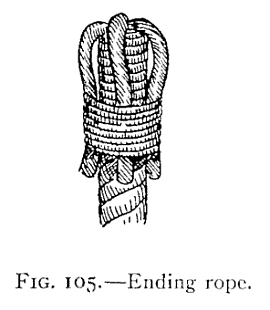
Another simple way of finishing a rope end is to seize the end, as at A,
Fig. 104, and open out the strands, bring the strands back alongside the rope,
and whip the whole (Fig. 105).
Splicing is, in many cases, more useful and better than tying or
bending ropes together and a good splice always looks neater and more
ship-shape than a knot, no matter how well-made it may be. A person
familiar with splicing will turn in a splice almost as quickly as the
ordinary man can tie a secure knot, and in many cases, where the rope
must pass through sheaves or blocks, a splice is absolutely necessary
to fasten two ropes or two parts of a parted rope together.

The simplest of all splices is known as the "Short Splice" (Fig. 106).
This is made as follows: Untwist the ends of the rope for a few inches
and seize with twine to prevent further unwinding, as shown at A, A;
also seize the end of each strand to prevent unravelling and grease
or wax the strands until smooth and even. Now place the two ends of
the ropes together as shown at B, B. Then with a marline-spike, or a
pointed stick, work open the strand 1c, and through this pass the
strand A of the other rope; then open strand 2 and pass the next
strand of the other rope through it and then the same way with the
third strand. Next open up the strands of the other rope, below the
seizing, and pass the strands of the first rope through as before, 3
A, B.

The ropes will now appear as in Fig. 106, D. Now untwist the
six strands and cut away about half the yarns from each and seize the
ends as before; pass these reduced strands through under the whole
strands of the rope—the strands of the left under the strands of the
right rope and vice versa—for two or three lays and then cut off
projecting ends, after drawing all as tight as you can. If an
extra-neat splice is desired the strands should be gradually tapered
as you proceed, and in this way a splice but little larger than the
original diameter of the rope will result. The only difficulty you
will find in making this splice is in getting the strands to come
together in such a way that two strands will not run under the same
strand of the opposite rope. To avoid this, bear in mind that the
first strand must be passed over the strand which is first next to it
and through under the second and out between the second and third. In
the following operations the strands are passed over the third and
under the fourth; but the figures will make this perfectly clear.

A far better and stronger splice is the "Long Splice," which will run
through any block or tackle which will admit the rope itself; indeed,
a well-made long splice cannot be distinguished from the rope itself
after a few days' use (Fig. 107). To make this useful splice, unlay
the ends of the rope about four times as much as for the short splice,
or from four to five feet, unlay one strand in each rope for half as
much again; place the middle strands together as at A, then the
additional strands will appear as at B and C, and the spiral
groove, left where they were unlaid, will appear as at D and E.
Take off the two central strands, F and G, and lay them into the
grooves, D, E, until they meet B and C, and be sure and keep
them tightly twisted while so doing. Then take strands H and J,
cut out half the yarns in each, make an overhand knot in them and tuck
the ends under the next lays as in a short splice. Do the same with
strands B, C and F, G; dividing, knotting, and sticking the
divided strands in the same way. Finally stretch the rope tight, pull
and pound and roll the splice until smooth and round, and trim off all
loose ends close to the rope.

An "Eye Splice" (Fig. 108) is very easy to make and is useful and
handy in a great variety of ways. It is made in the same manner as the
short splice, but instead of splicing the two ends together, the end
of the rope is unlaid and then bent around and spliced into its own
strands of the standing part, as shown in the illustration.

A "Cut Splice" (Fig. 109) is made just as an eye splice or
short splice, but instead of splicing two ropes together end to end, or splicing
an end into a standing part, the ends are lapped and each is spliced into the
standing part of the other, thus forming a loop or eye in the centre
of a rope. Once the short and long splices are mastered, all other
splices, as well as many useful variations, will come easy.
Oftentimes, for example, one strand of a rope may become worn, frayed,
or broken, while the remaining strands are perfectly sound. In such
cases the weak strand may be unlaid and cut off and then a new strand
of the same length is laid up in the groove left by the old strand
exactly as in a long splice; the ends are then tapered, stuck under
the lay, as in a short splice, and the repair is complete; and if well
done will never show and will be as strong as the original rope.
CHAPTER VII
FANCY KNOTS AND ROPE WORK
The knots and splices described above are all more for practical use
than ornament, although such shortenings as the Single and Double
plaits, the Chain knots, the Twofold, Fourfold, and Sixfold knots, and
others are often used for ornamental purposes only. A certain class of
knots are, however, really ornamental and seldom serve to fasten two
ropes together, or to make any object fast to another. They are,
however, very useful in many ways, especially aboard ship, and they
are so handsome and interesting that every one interested in rope work
should learn to make them.
The simplest of the fancy knots is known as
the "Single Crown" (Fig. 110). To form this knot unlay the strands of
a new, flexible rope for six to eight inches and whip the ends of each
strand, as well as the standing part, to prevent further untwisting.
Hold the rope in your left hand and fold one strand over and away
from you, as shown in A, Fig. 111. Then fold the next strand over
A (see B, Fig. 111), and then, while holding these in place with
thumb and finger, pass the strand C over strand B, and through the
bight of A as shown in the illustration. Now pull all ends tight and
work the bights up smooth and snug; cut off ends and the knot is
complete. This single crown is a very poor knot to stand by itself,
however, and is mainly valuable as a basis for other more complicated
knots and for ending up rope.
To end up a rope with a crown it is merely necessary to leave the projecting ends
long and then by bringing them down tuck under the strands of the standing part,
as shown in Fig. 112.
Then halve the strands and tuck again, as in
making a short splice, until the result appears as in Fig. 113. This
makes a neat, handy, and ship-shape finish to a rope's end and is very
useful for painters, halyards, etc. It will never work loose like a
seizing and is quickly put on at any time, whereas to make a seizing
one must be provided with small stuff of some sort, and this is
frequently not at hand.
The "Wall Knot" (Fig. 114) is almost as simple
as the crown, and in fact is practically a crown reversed.
In making this knot bring C downward and across the standing part;
then bring A over C and around standing part and finally
bring B over A and up through bight of C, Fig. 115.
When drawn snug the ends may be trimmed off close or they may
be tucked and tapered as in the crown and will then appear as in Fig. 116.
As in the case of the crown knot, the wall is mainly of value as an
ending when ends are tucked, or as a basis for more ornamental knots
such as the "Wall and Crown," or "Double Wall,"
or "Double Crown." It is also very largely used in
making "Shroud Knots" (Fig. 117).
The common shroud knot is made by opening up the strands of
a rope's end as for a short splice and placing the two ends together
in the same way. Then single "wall" the strands of one
rope around the standing part of another against the lay, taper the ends,
and tuck and serve all with yarn or marline (Fig. 118).
The "French Shroud Knot" is far neater and better, but is a
little harder to make. Open up the strands and place closely together
as for the short splice; make a loop of strand A, pass the end of
B through the bight of A, as at C, make a loop of strand D,
and pass the end of strand A through it as at D; then pass the end
of strand D through the bight of strand B and one side is
complete.
Repeat the operation on the other side, draw all ends taut,
and taper and tuck the ends. The whole should then be served carefully
and the finished knot will appear as in Fig. 120.
Double wall and double crown as well as the beautiful double
wall-and-crown knots are made exactly like the single crown or wall
but instead of trimming off or tucking the ends they are carried
around a second time following the lay of the first, as shown in Fig.
121, which shows the construction of a double crown at A, and a
double wall at B.
When finished, the ends may be tucked or trimmed
and the two knots will look like Figs. 122 and 123.
A far better effect is obtained by "Crowning" a wall knot.
This is done by first making a single wall knot and then by
bringing strand A up over the top and laying B across A
and bringing C over B and through
the bight of A; a crown knot is formed above the wall, as shown in
Figs. 124 and 125.


This is the foundation of the most beautiful of
rope-end knots, known as the "Double Wall and Crown," or "Manrope
Knot," illustrated in Fig. 126. Make your single wall and crown it,
but leave the strands all slack; then pass the ends up and through the
bights of the slack single-wall knot and then push them alongside the
strands in the single crown; pushing them through the same bight in
the crown and downward through the walling. This may seem quite
difficult, but if you have learned the wall and crown you will find it
simple enough, for it is really merely "following" the strands of the
single wall and crown.
The result, if properly done, and ends drawn tight and
cut off closely, is surprising, and to the uninitiated most
perplexing, for if the ends are tapered and tucked through the
standing part of the ropes, as shown in Fig. 127, there will be no
sign of a beginning or ending to this knot. This is probably the most
useful of decorative knots and is largely used aboard ship for
finishing the ends of rope railings, the ends of man-ropes, for the
ends of yoke-lines and to form "stoppers" or "toggles"
to bucket handles, slings, etc.
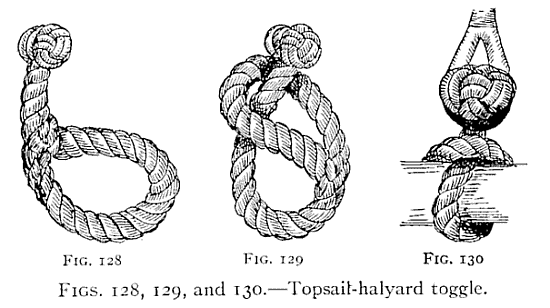
Its use in this way is illustrated in Figs.
128-130, which show how to make a handy topsail-halyard toggle from an
eye splice turned in a short piece of rope and finished with a double
wall and crown at the end. These toggles are very useful about small
boats, as they may be used as stops for furling sails, for slings
around gaffs or spars, for hoisting, and in a variety of other ways
which will at once suggest themselves to the boating man.
The most difficult of ending knots and one which you should certainly
learn is the "Matthew Walker" (Fig. 131), also known as the "Stopper
Knot." To form this splendid knot, pass one strand around the
standing part of the rope and through its own bight, then pass B
underneath and through bight of A and through its own bight also;
next pass C underneath and around and through the bights
of A, B, and its own bight.
The knot will now appear as in Fig. 132, but by
carefully hauling the ends around and working the bight taut a little
at a time the knot will assume the appearance shown in Fig. 133.
This is a handsome and useful knot and is widely used on ends of ropes
where they pass through holes, as for bucket handles, ropes for
trap-door handles, chest handles, etc. The knot is well adapted for
such purposes, as it is hard, close, and presents an almost flat
shoulder on its lower side.

The "Turk's Head," Figs. 135 and 136, is a knot much used aboard
yachts and warships and is so handsome and ornamental that it is a
great favorite. It is used in ornamenting rigging, in forming
shoulders or rings on stays or ropes to hold other gear in place, to
ornament yoke lines, and for forming slip-collars on knife lanyards.
It is also used to form collars around stanchions or spars, and,
placed around a rope close beneath a man-rope knot, it gives a
beautiful finish. When made of small line sailors often use the Turk's
Head as a neckerchief fastener. Although so elaborate in effect, it is
really an easy knot to make, and while you may have difficulty in
getting it right at first a little patience and practice will enable
you to become proficient and capable of tying it rapidly and easily in
any place or position.
To make a Turk's Head, have a smooth, round
stick, or other object, and some closely twisted or braided small
line. Pass two turns of the line around the rod, A, Fig. 135, from
left to right, and pass the upper bight down through the lower and
reeve the upper end down through it, as at B. Then pass the bight up
again and run the end over the lower bight and up between it and the
upper bight. Turn the upper bight again through the lower one and pass
the end over what is now the upper bight and between it and the
lower, C, Fig. 135.
Now work from left to right, following the lay
of the knot (or, in other words, passing your long end alongside the
first end), D, Fig. 135, until a braid of two or more lays is
completed, as shown in Fig. 136. The Turk's Head may be drawn as tight
as desired around the rope, or rod, by working up the slack and
drawing all bights taut.
A variation of the knot may be formed by
making the first part as described and then by slipping the knot to
the end of the rod; work one side tighter than the other until the
"Head" forms a complete cap, as shown in Fig. 137. This makes a
splendid finish for the ends of flagpoles, stanchions, etc.

Ropes that are to be used as hand-lines, stanchions, man-ropes,
railings, or in fact wherever a neat appearance counts, are usually
wormed, served, and parcelled. Worming consists in twisting a small
line into the grooves between the strands of rope, A, Fig. 138. This
fills up the grooves and makes the rope smooth and ready for serving
or parcelling. Parcelling consists in covering the rope already wormed
with a strip of canvas wound spirally around it with the edges
overlapping, B, Fig. 138. Serving is merely wrapping the rope with
spun yarn, marline, or other small stuff, C, Fig. 138. Although this
may all be done by hand, yet it can be accomplished far better by
using a "Serving Mallet," shown in D, Fig. 138. This instrument
enables you to work tighter and more evenly than by hand, but in
either case you must have the rope to be served stretched tightly
between two uprights.

Often a rope is served without parcelling and
for ordinary purposes parcelling is not required. A variation of
serving is made by "half-hitch" work, as shown in Figs. 139-140.
This is very pretty when well done and is very easy to accomplish.
Take a half-hitch around the rope to be served, then another below it; draw
snug; take another half-hitch and so on until the object is covered
and the series of half-hitch knots forms a spiral twist, as shown in
the illustrations. Bottles, jugs, ropes, stanchions, fenders, and
numerous other articles may be covered with half-hitch work; and as
you become more expert you will be able to use several lines of
half-hitches at the same time.
Four-strand braiding is also highly
ornamental and is easy and simple. The process is illustrated in Fig.
141, and consists in crossing the opposite strands across and past one
another, as shown in A, B, C, Fig 141.
Still more ornamental is the
"Crown-braid" which appears, when finished, as in Fig. 143. The
process of forming this braid is exactly like ordinary crowning and
does not require any description; it may be done with any number of
strands, but four or six are usually as many as the beginner cares to
handle at one time.
When the rope-worker has mastered all the knots, ties, bends, hitches,
and splices I have described, he will find a new field open to the use
of rope in innumerable ways. Barrels, casks, bales, or other objects
may be roped, or slung, with ease and security; ropes will be pressed
into service for straps and belts; and buckles may be readily formed
by the simple expedient shown in Fig. 144.
If a swivel is required it can be arranged as shown in Fig. 145, while
several simple slings are illustrated in Figs. 146-148. In a factory, or machine shop,
rope belting will often prove far better than leather, and if well spliced
together will run very smoothly and evenly even on long stretches. As
a recreation for killing time aboard ship, or on rainy vacation days,
few occupations will prove more enjoyable than tying fancy knots and
making new splices and bends or inventing new variations of the
numerous hitches, ties, and knots you already know.
HALTERS FOR ANIMALS
Every now and then a temporary halter is needed for a horse, and in
Fig. 149 such a halter is shown. This halter is made by putting the
end of a long rope around the neck of the horse and then tying a
common bow-line knot. (See Fig. 150.)
Fig. 151 shows the second step to be followed, that of passing the rope
around the animal's head twice, while Fig. 152 shows how the second loop
is passed under the first.
In Fig. 153 the rope is shown sufficiently long enough to
enable it to be passed over the ears of the animal and leave the
halter completed, as shown in Fig. 154.
INDEX
Artificial eye
Baggage
Barrels
Beams
Belaying-pin
Belaying-pin splice
Belting
Bends
Bight
Billet
Blackwall hitch
Blocks
Bolt-rope
Bow-knots
Bow-line
Bow-line on bight
Bow shortening
Boxes
Bridles
Builders' hitch
Builders' knot
Bundles
Butchers' knots
Cable
Casks
Catspaws
Chain hitch
Chain knots
Chests
Cleat tie
Clinches
Close band
Clove hitch
Cordage
Core
Cotton
Cotton rope
Crown braid
Crowning
Crown knots
Cuckolds' necks
Cut splice
Deadeye lashing
Deadeyes
Dogshanks
Double chain
Double crown
Double figure-eight
Double knots
Double plait
Double wall
Double wall and crown
End
Ending
Ending rope
End pointing
Eyes
Eye splice
Fancy knots
Fibres
Fid
Figure-eight knot
Fisherman's hitch
Fisherman's knot
Fivefold knot
Flemish eye
Fourfold knot
Four-strand braid
Four-stranded rope
French shroud knot
Gaff-topsail halyard bend
Garrick bend
Gordian knot
Granny knot
Grass
Grommets
Gunners' knot
Gut lines
Half-hitch
Half-hitch and seizing
Half-hitch work
Handcuff kings
Handcuffs
Handles
Handspike
Hawser hitch
Hawsers
Hemp
Hemp rope
History of rope
Hitches
Hooks
Introduction
Jute
Lanyards
Larks' heads
Lashed cut splice
Lashings
Laying up
Leather braid
Left-handed rope
Long splice
Loop lashings
Loop knots
Loops
Magnus hitch
Manacles
Manila rope
Manrope knot
Marline
Marline spike
Marline-spike seamanship
Matthew Walker knot
Midshipman's hitch
Monkey chain
Mooring knots
Necklace tie
Nettles
Nooses
Open chain
Open-hand knot
Ordinary knot
Overhand knot
Packages
Parcelling
Parts of rope
Pier bend
Pointed rope
Pointing
Quoits
Reef knot
Reefing knots
Repairing rope
Rigging
Right-hand rope
Rings
Roband hitch
Rolling hitch
Rope
Rope buckles
Rose lashing
Round turn
Running bow-line
Running knot
Running noose
Sailors' knots
Seized shortening
Seizing
Selvagee
Selvagee board
Selvagee strap
Serving
Serving mallet
Sevagee
Sheaves
Sheepshanks
Shortenings
Short splice
Shroud knots
Silk
Simple hitch
Simple knots
Single plait
Sinkers
Sisal flax
Sixfold knot
Slings
Slip knots
Slippery hitch
Snaking
Spars
Spiles
Splices
Splicing
Square knots
Standing part
Stopper knot
Stoppers
Stops
Strands
Straps
Strength of rope
String
Studding-sail bend
Swivels
Tackle
Threefold knot
Throat seizing
Ties
Timber
Timber hitch
Toggles
Tomfool knot
Topsail-halyard toggle
Treble knot
Turks' caps
Turks' heads
Twine
Twist braid
Twist knot
Twist shortening
Twists
Wall and crown
Wall crowned
Wall knots
Warp
Waterman's knot
Weaver's knot
Wedding knot
Weight of rope
Wharf tie
Whipping
Wind knots
Wire rope
Worming
Yarn
















